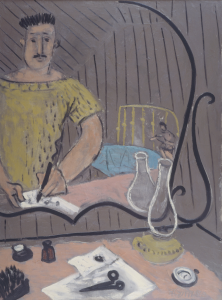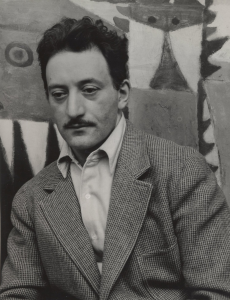

Biography
Adolph Gottlieb (born Adolf) was born in New York in 1903. He left high school to work in his father's stationery business, Gottlieb & Sons. As a teenager he enrolled in the Art Students League, taking night classes from John Sloan and attending lectures by Robert Henri. He shared a studio with Chaim Gross, Louis Schanker, and the brothers Moses and Isaac Soyer. In 1921 he traveled to Europe by working on a steamship. For three months in Paris he made daily visits to the Louvre and took sketching classes at the Académie de la Grande Chaumière. The next year he traveled around the continent before returning to New York.
Back working at Gottlieb & Sons, Adolph took high school classes in the evenings. He re-enrolled at the Art Students League (ASL) and had classes with John Sloan and Henry Schnackenberg. At ASL he met Barnett Newman and John Graham, who became life-long friends. He was able to show his work at the Opportunity Gallery in 1928-1929, where he also met Milton Avery and Mark Rothko. A first prize in the Dudensing National Competition led to a solo exhibit at the Dudensing Gallery.
In 1930 Gottlieb rented a studio that he shared occasionally with Barnett Newman. He had another solo exhibit, followed in 1931 and 1932 with exhibits at the Opportunity Gallery. In 1932 he married Esther Dick, an artist whom he had met a few years earlier. He and his bride spent the summer in Rockport, MA with Milton Avery and his wife Sally. This was a pattern repeated in subsequent years.
In 1933, Gottlieb replaced the "f" in his given name to a "ph" in response to the rise of Adolf Hitler. He met the sculptor David Smith, who was a neighbor of his in Brooklyn. He also purchased an etching press that he used to make prints at his home for the next 15 years.
Gottlieb's work was included in the inaugural show for Gallery Secession in 1935. The same year Gottlieb helped found "The Ten," a group of expressionist and abstract painters. He traveled again to Europe and became interested in African art under the influence of his friend, the modernist painter John Graham.
In 1936 Gottlieb joined the activist groups the Artists Union and the American Artists’ Congress. He was in the Easel Division of the WPA from 1936-1937. More significantly for the development of his art, Adolph and Esther spent 8 months in Tucson for the sake of Esther's health in 1937-1938. This was a period of experimentation and simplification for Gottlieb, laying the groundwork for breakthroughs in the next few years. Returning to New York he won the competition for a mural in the Yerington, NV Post Office in 1939 with his "Homestead on the Plain."
In 1940 Gottlieb resigned from the American Artists' Congress over their failure to oppose the Hitler-Stalin non-aggression pact. He was one of the founders of "The Federation of Modern Painters and Sculptors," serving on the Federation's Cultural Committee with Mark Rothko. The same year his Arizona paintings were shown in a solo exhibit at the Artists' Gallery in New York.
In 1941 Gottlieb and Rothko agreed to pursue abstraction by addressing subject matter related to classical mythology. This was an outgrowth of the experiments Gottlieb had undertaken in Arizona. His painting "Pictograph - Symbol" was shown in 1942, followed by a solo exhibit of related Pictograph paintings at the Artists' Gallery. Rothko, for his part began his series of Mythic paintings.
In 1943 Gottlieb, Rothko, John Graham and George Constant founded New York Artists—Painters, and Gottlieb showed his work in their first exhibition. Gottlieb and Rothko published a formal statement on Abstract Expressionism in the New York Times. There followed a number of exhibits of Gottlieb's work as Abstract Expressionism blossomed.
By 1951 Gottlieb had moved from Pictographs to a different style, his "Imaginary Landscapes." And in 1952 he created a stained glass facade for the Park Avenue Synagogue. More exhibits followed in the 1950s. Gottlieb taught evening classes at the Pratt Institute from 1955-1959. His first "Burst" painting appeared in 1956.
Gottlieb suffered a heart attack in 1962. The next year he had a major survey exhibit at the Walker Art Center in Minneapolis and was awarded the Grande Prêmio at the VII Bienal de São Paulo in Brazil. He resumed printmaking (for the first time since 1949) in 1966. And he joined the faculty of the Sarasota New College of Fine Arts with Philip Guston, Jim Dine and others in 1967. A retrospective of Gottlieb's work was shown simultaneously at the Whitney and the Guggenheim in New York in 1968, followed by a retrospective at the Corcoran Gallery in Washington.
Gottlieb started sculpting that year, and he also tried his hand at the design of tapestries. He was partially paralyzed by a stroke in 1971 but continued painting. He died in 1974 in New York, where a memorial exhibit was held at the Museum of Modern Art. Following his death, the Adolph and Esther Gottlieb Foundation was established to assist individual artists in their work.


Critical Analysis
Adolph Gottlieb, through his key friendships and his personal artistic development, was an important player in the creation of the Abstract Expressionist movement. Gottlieb's work evolved through several stages. In his early career he followed an expressionist realist style. Following his time in Arizona he laid the groundwork for Abstract Expressionism with his "Pictograph" paintings, the first of which appeared in 1942. These works were characterized by a flattened space, a simple grid architecture and the use of powerful symbols.
Gottlieb's next phase of painting involved his "Imaginary Landscapes," starting in 1951. These paintings typically divided the canvas into upper and lower halves, with the upper half involving a few dramatic and colorful shapes and the lower half a horizontal swath of color.
A further evolution of Gottlieb's work came in 1956, when he produced his first "Burst" painting. These paintings further simplified his work and typically included dramatic bursts of color at the top, with a less organized swirl of black paint at the bottom. In these works the horizon line of the Imaginary Landscapes has disappeared, although the general upper/lower structure of the Landscapes remains.
It's interesting to look at Gottlieb's Yerington Post Office mural in light of his future evolution. Compared to most other public works of that era, Gottlieb's mural is strikingly abstract. Nominally a western landscape, the details of the trees, the buildings and the car are so sketchy as to reduce them to spots of color and mere lines on the canvas. The result - along with the monumental hills that dominate the work - is to emphasize shapes and colors above representational content. In this regard it's easy to see where Gottlieb might have been heading with this work. It appeared at a particularly interesting juncture in his career, when he was departing from representational art and helping to launch the Abstract Expressionist movement.
Murals
- Yerington, Nevada - Post Office: Homestead on the Plain
References
- The Adolph & Esther Gottlieb Foundation (The Adolph & Esther Gottlieb Foundation).
- Adolph Gottlieb (Pace).
- Adolph Gottlieb (Wikipedia).
- Federation of Modern Painters and Sculptors (Federation of Modern Painters and Sculptors).
- A Look Back: The Gottliebs In Arizona, Adolph & Esther Gottlieb Foundation Blog April 20 (2021).